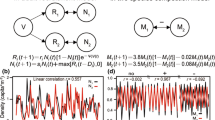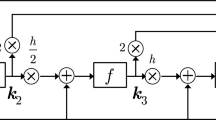Abstract
This paper is devoted to the construction of a stochastic nonlinear dynamical system for signal generation such as the production of voiced sounds. The dynamical system is highly nonlinear, and the output signal generated is very sensitive to a few parameters of the system. In the context of the production of voiced sounds the measurements have a significant variability. We then propose a statistical treatment of the experiments and we developed a probability model of the sensitive parameters in order that the stochastic dynamical system has the capability to predict the experiments in the probability distribution sense. The computational nonlinear dynamical system is presented, the Maximum Entropy Principle is used to construct the probability model and an experimental validation is shown.
Similar content being viewed by others
References
Ishizaka K and Flanagan JL (1972). Synthesis of voiced sounds from a two-mass model of the vocal cords. Bell Syst Tech J 51: 1233–1268
Zhang Y, Jiang J, Rahn III DA (2005) Studying vocal fold vibrations in Parkinson’s disease with a nonlinear model Chaos 033903: 1–10
Cataldo E, Leta FR, Lucero J and Nicolato L (2006). Synthesis of voiced sounds using low-dimensional models of the vocal cords and time-varying subglottal pressure. Mech Res Commun 33: 250–260
Lucero JC (1995). The minimum lung pressure to sustain vocal fold oscillation. J Acoust Soc Am 98: 779–784
Titze I (1994). Principles of voice production. Prentice-Hall, Englewood Cliffs, NJ
Sciamarella D and Alessandro C (2004). On the acoustic sensitivity of a symmetrical two-mass model of the vocal fols do the variation of control parameters. Acta Acustica United Acustica 90: 746–761
Pinto N and Titze I (1990). Unification of perturbation measures in speech signals. J Acoust Soc Am 87(3): 1278–1289
Fant G (1960). The acoustic theory of speech production. Mouton, The Hague
Soize C (2001). Maximum entropy approach for modeling random uncertainties in transient elastodynamics. J Acoust Soc Am 109: 1979–1996
Schoengten J (2001). Stochastic models of Jitter. J Acoust Soc Am 109: 1631–1650
Jaynes E (1957). Information theory and statistical mechanics. Phys Rev 106(4): 620–630
Jaynes E (1957). Information theory and statistical mechanics II. Phys Rev 108: 171–190
Shannon CE (1948) A mathematical theory of communication. Bell System Tech J 27:379–423, 623–659
Baer T (1975) Investigation of phonation using excised larynges. Ph.D. thesis, Massachussetts Institute of Technology, Cambridge, MA
Kapur JN and Kesavan HK (1992). Entropy optimization principles with applications. Academic Press, San Diego
Serfling R (1980). Approximation theorems of mathematical statistics. Wiley, New York
Author information
Authors and Affiliations
Corresponding author
Rights and permissions
About this article
Cite this article
Cataldo, E., Soize, C., Sampaio, R. et al. Probabilistic modeling of a nonlinear dynamical system used for producing voice. Comput Mech 43, 265–275 (2009). https://doi.org/10.1007/s00466-008-0304-0
Received:
Accepted:
Published:
Issue Date:
DOI: https://doi.org/10.1007/s00466-008-0304-0




